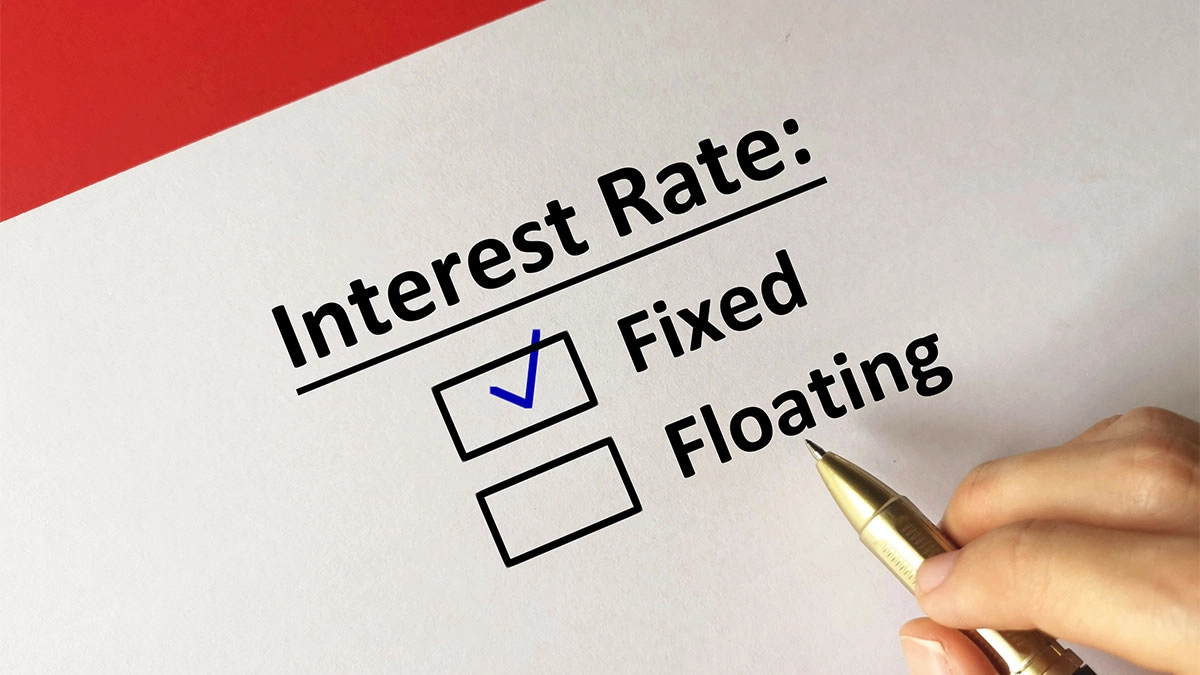When applying for a Loan Against Property (LAP), one of the most important decisions is choosing between a fixed or floating interest rate. This choice directly impacts your Equated Monthly Instalments (EMIs) and overall repayment cost. Understanding the differences between these two interest rate types can help you make an informed financial decision. Read on!

Types of Interest Rates
Interest rates on loans generally fall into two categories:
- Fixed Interest Rate: The interest rate remains constant throughout the entire term of the loan, regardless of changes in the market conditions.
- Floating Interest Rate: It is a variable interest rate that changes periodically based on market conditions.
Each type has its advantages and drawbacks, depending on your financial stability and risk appetite. Let’s understand how both types of interest rates work in the next section.
How Does a Fixed Interest Rate on a Loan Against Property Work?
A fixed interest rate ensures that your EMI remains unchanged throughout the loan tenure. This means that regardless of market fluctuations, your repayment amount stays the same. Fixed-rate loans are ideal for you if you require predictability and stability in your financial planning.
For example, if you take a Loan Against Property with a fixed interest rate of 8% for 10 years, your EMI will remain constant, allowing you to budget effectively without worrying about rate hikes.
Benefits of a Fixed Interest Rate on a Mortgage Loan
Opting for a fixed interest rate offers several advantages:
1. Predictable Monthly Payments
Your EMI stays the same throughout the loan tenure, making it easier to plan your monthly budget without surprises.
2. Protection from Market Volatility
Even if interest rates rise in the broader economy, your rate and your payments remain unaffected. That’s a big win during inflationary periods.
3. Long-Term Financial Planning
Fixed rates are ideal for you if you want to map out your finances over the long haul, especially for loans with tenures of 15 to 30 years.
4. Peace of Mind
There’s comfort in knowing exactly what you owe each month. No need to track market trends or worry about sudden hikes.
5. Simplicity
Fixed-rate loans are straightforward. You don’t need to understand complex benchmark-linked pricing or worry about periodic resets.
How Does a Floating Interest Rate on a Loan Against Property Work?
A floating interest rate varies based on market conditions and is linked to benchmark rates like the RBI repo rate. This means your EMI may increase or decrease depending on economic trends.
For instance, if the repo rate drops, your interest rate may decrease, leading to lower EMIs. Conversely, if the rate rises, your repayment amount will increase.
Benefits of a Floating Interest Rate on a Mortgage Loan
Choosing a floating interest rate can be beneficial in several ways:
1. Lower Initial Rates
Floating rates typically start lower than fixed rates, which means your initial EMIs are lighter on the wallet.
2. Potential for Cost Savings
If market interest rates fall, so does your loan rate, translating to reduced EMIs or a shorter loan tenure. Over time, this can significantly cut down your total interest outgo.
3. Shorter Loan Tenure Possibility
When rates drop, instead of reducing your EMI, lenders may shorten your loan term, helping you become debt-free sooner.
4. Ideal for Falling Rate Environments
If you anticipate that interest rates will decline or remain stable, a floating rate lets you ride that trend to your advantage.
Difference Between a Fixed and Floating Interest Rate
|
Feature |
Fixed Interest Rate |
Floating Interest Rate |
|
Interest Rate |
Remains constant throughout the loan tenure |
Varies based on market conditions and benchmark rates |
|
EMI Amount |
Fixed and predictable |
Can increase or decrease over time |
|
Market Impact |
Not affected by market fluctuations |
Directly influenced by changes in interest rates |
|
Initial Rate |
Usually higher than floating rates |
Typically, lower at the start |
|
Budgeting |
Easier due to consistent payments |
Requires flexibility in financial planning |
|
Prepayment Charges |
May include penalties |
Often, no or minimal penalties |
|
Best Suited For |
Long-term planners seeking stability |
Individuals expecting interest rates to fall |
To Conclude
Choosing between fixed and floating interest rates depends on your financial goals and risk tolerance. If you prefer stability, a fixed rate is ideal. On the other hand, if you want to take advantage of market fluctuations, a floating rate may be more beneficial. However, if you are looking to make the most of your property’s value with transparent terms, flexible repayment options, and competitive interest rates, look no further than a Loan Against Property from Poonawalla Fincorp. Apply today!
Frequently Asked Questions
1. Which interest rate is better for a Loan Against Property?
It depends on your financial situation. Fixed rates offer stability, while floating rates provide flexibility.
2. Can I switch from a fixed to a floating rate?
Yes, some lenders allow borrowers to switch between interest rate types during the loan tenure.
3. Do floating rates always increase?
No, floating rates fluctuate based on market conditions. They can decrease if benchmark rates drop.
We take utmost care to provide information based on internal data and reliable sources. However, this article and associated web pages provide generic information for reference purposes only. Readers must make an informed decision by reviewing the products offered and the terms and conditions. Loan disbursal is at the sole discretion of Poonawalla Fincorp.
*Terms and Conditions apply